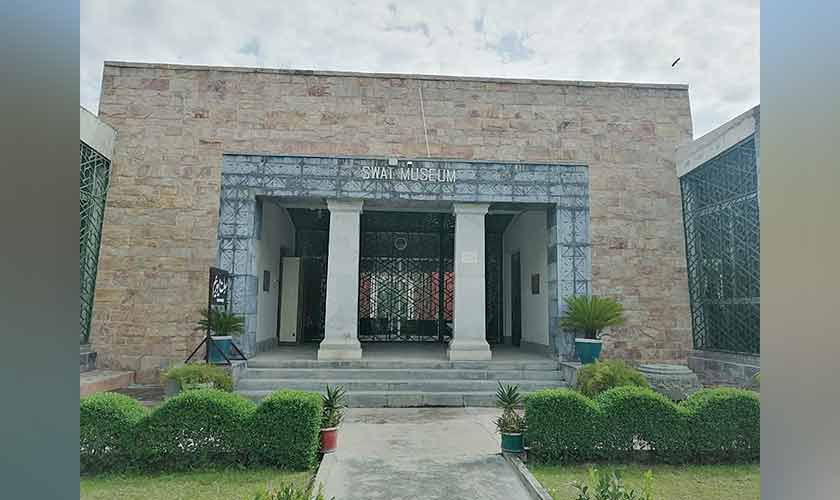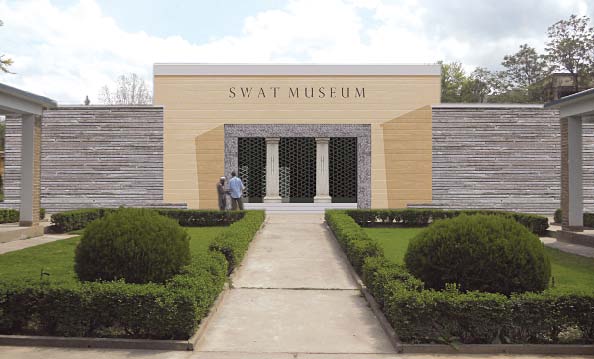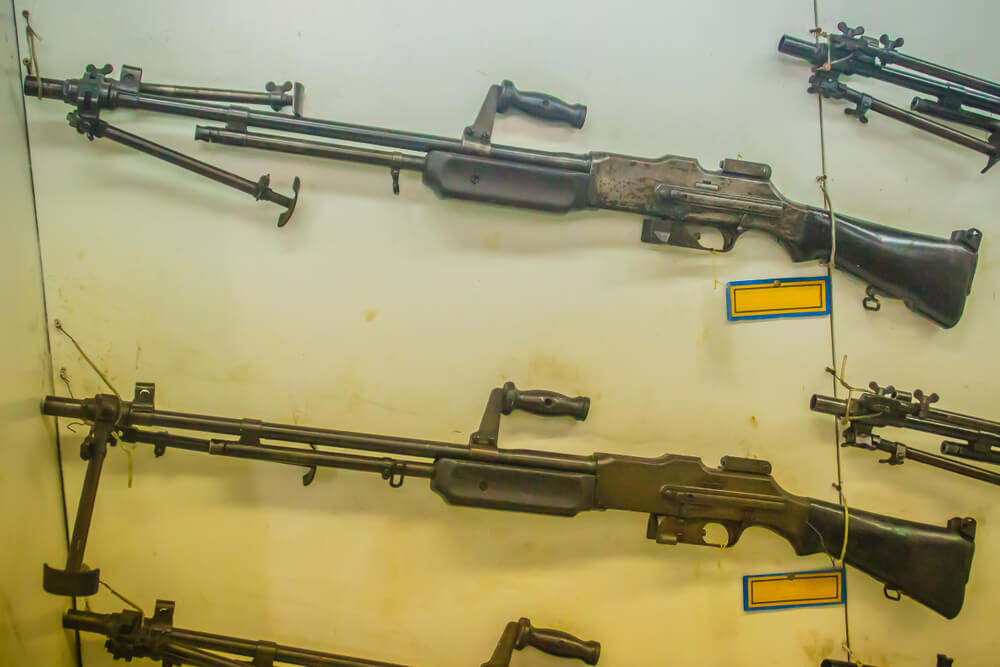Swat Museum
Swat Museum Mingora is one of Pakistan’s largest and most popular archaeological museums. It is a museum and an institution to gather knowledge about different civilizations and feature artifacts demonstrating the evolution and development of Gandhara Art and Buddhism in the Swat region. It represents a sculptural presentation of Buddhist art and diverse architectural style.
So if you’re ever in the vicinity of Swat, pay a visit to this vast archaeological landmark.
History of Swat Museum
The Museum was constructed in 1955 by an Italian architect on the instructions of the Governor of Swat, who collected numerous antiquities to preserve Swat’s history. The President of the Italian institute selected two sites near Mingora for excavation, i.e., Udigram and Butkara. Many Italian and Pakistani institutes conducted archaeological investigations and excavations in Swat Valley and discovered numerous Buddhist sculptures and artifacts. The architects obtained these artifacts from various regions of Swat valley, which is why it is called the ”Varia Collection”. To accommodate and exhibit these artifacts, a Building or Museum was required. So, the collaboration of the Italian and Japanese governments built a museum in 1955 to preserve the collection of historical artifacts.
Unfortunately, the old Museum badly deteriorated in 2005 because of the Kashmir earthquake. Later, it got damaged by a bomb blast in 2007 during a war that raged between Pakistan and the Taliban. Then the artifacts were temporarily shifted to the Taxila Museum. The Government of Swat recognized the historical significance the Museum holds; as a result, the Museum was renovated and made seismic-resistant with the help of an Italian archaeological mission in 2018. Swat Museum opened to the public on 11 December 2014. The Museum showcases up to 3000 objects relating to Gandhara Art, Buddha’s life, Buddha’s and Bodhisattvas sculptures, stucco heads, and architectural panels.
Who Built Swat Museum?
The construction of the Swat Museum in Saidu Sharif is evidence of Italy’s allegiance in contributing to the preservation of Pakistan’s cultural heritage. Designed by Italian architects Ivano Marathi and Candida Vassallo and set up with the help of Italian and Pakistani architects from the University of Engineering and Technology (UET) and the University of Peshawar, Swat Museum is the most structurally advanced landmark in Pakistan with a vast collection of Gandhara Civilization. It took an estimated cost of $700,000 to construct the Swat Museum in Mingora. Syed Aqil Shah, minister of Khyber Pakhtunkhwa, laid the foundation for reconstructing the Swat Museum in 2012.

Galleries Inside Swat Museum
Swat Museum Mingora comprises various spacious galleries showcasing enchanting antiquities for its visitors to ponder upon the cultural values of the ancient civilizations. The sculptural artifacts of Gandhara Art will leave you amazed. You come across many cultures, religions, and conquerors that entered the Swat valley over the centuries Aryans, Buddhists, Chinese, Muslims, and Persians. Moreover, it features beautifully preserved old furniture, Jewelry, and embroideries of historical significance. Let us dive into the detail of every gallery.
Gandhara Gallery
This gallery showcases various artifacts depicting Gandhara Art and Civilization. The Buddhist art of Gandhara appeared in the region of Swat Valley in the first century B.C. It stuck until the 8th century A.D. During the time of Kanishka, the worshippers and devotees of Buddha carved thousands of Buddha images and sculptures. Individual sculptures were shrined for worship in chapels of the monasteries and sometimes in the niches of the stupas. The materials used to make sculptures are green phyllite and gray-blue mica schist.
The artists of Gandhara also used stucco, terracotta, and bronze. The sculptures displayed in the Swat Museum are either seated or standing. The hands of Buddha are in the gestures of reassurance, meditation, preaching, and earth-touching. Buddha is always in a simple monastic robe with a halo.
The sculptors have beautifully carved all the episodes from Buddha’s birth to death through statuettes and friezes. The Gandhara Gallery features a piece of a frieze that is said to be the creation of a single studio working under the direction of Maestro of Saidu. Various architectural panels in the Swat Museum show the birth of the Buddha, the Enlightenment period during which Buddha meditated for forty days and reached the sense of omniscience. The earth-touching Gesture depicts the moment of enlightenment, the Gesture of raising one hand while delivering the first sermon at Sarnath. Various stucco heads of Buddha are also beautifully placed. Many Bejeweled Heads of Bodhisattva are displayed in the Swat Museum, discovered during an excavation of a stupa at Swat valley.
Islamic Gallery
It is the most prestigious gallery exhibiting a collection of old and ancient handwritten Holy Quran in various writing styles of the Arabic language. The copies of the Holy Book are all beautifully and meticulously placed on the glass shelves. The Islamic gallery features old Manuscripts of the Quran from the 8th to 13th Centuries excavated from the Saidu Sharif and Barikot regions. The Museum mentioned the authors’ names and publication dates with the manuscripts. Other featuring elements are prayer mats, prayer seats (Takht posh), Stands for Holy Quran, and Coffin.

Ethnic Gallery
The Ethnological Gallery of Swat Museum features the ethnological history of the Swat valley and its old civilizations. Visitors can observe the Pre-historic culture and lifestyle of the people of ancient times through special features on display.
One of the most important treasures at the Swat Museum is its collection of Jewelry. The Museum’s gallery includes earrings, pendants, finger rings, necklaces, bangles, bracelets, head ornaments, and shoulder ornaments. The intricate detailing on each piece is a testimony to the skills and expertise of the local craftsmen and women with fantastic talent who create this age-old traditional art. The embroidery works displayed at the Swat Museum are intricately patterned silk shirts, and multi-colored woven shawls embody their definitive history. Each unique handcrafted piece tells a story about rich traditions while preserving them for future generations. A significant portion of the Museum’s collection includes household objects in metal, stone, and woodwork, including spoons, teapots, cooking pots, large jars with handles, rounded bowls, carinated vases, cups, and glasses. Traditionally carved Swati furniture is also a featuring element of the ethnic gallery.
Protohistory Gallery
Swat valley is famous for its numerous archaeological discoveries. Several archaeological sites, such as Barama, Aligrama, Gogdara, and Amankot, attracted the attention of academics and architects in the beginning. During this archaeological survey, hundreds of Buddhist monastic complexes were discovered and used to determine the chronology of the Swat valley. Various artifacts of the protohistoric period are displayed in the Swat Museum, holding a significant amount of interest for visitors. Several statues and sculptures of the Paleolithic Period are the centers of attention in this gallery. Artisans used rudimentary chipped stone tools to make stone-age, Bronze-age bone tools, hand axe, scrapers, pastels, perforated knives, and bronze-age female figurines are also beautifully preserved.

Early Settlements Gallery
This gallery refers to the artifacts found in 1960 during the excavation of Ghalegai village of Swat and Butkara II graveyard. This gallery is showcasing an extensive collection of artifacts, including:
⦁ Potsherd and globular jars
⦁ Drinking stemmed bowls
⦁ Bicarinated bowls and vases
⦁ Small legged square flask
⦁ Carinated stemmed goblet
⦁ Incised bottles and bowls
⦁ Miniature handmade vessels
⦁ Coins of the 2nd century obtained during excavation in the Kusama and Kusama-Sassanian periods are also displayed.
Late Antiquity Gallery
This gallery features a great collection of ancient antiquities of the third to sixth centuries obtained through the excavation of Barikot. The featuring elements of this gallery are animal figurines of a horse, lion, and humped bull.
Other artifacts are small crude lamps, Pilgrim’s flask, terracotta cultic figurines, stucco figurines of Bodhisattva, arrowheads, and door hinges.
Conference Hall
The Swat Museum Mingora has a spacious conference hall and proper seating arrangement. The purpose of the conference hall is to organize seminars and lectures to educate the general public about the historical significance of the Swat Museum.
Beautiful Sitting Lawns
As you enter the museum premises, you first encounter a vast garden full of lush green trees. You can sit and enjoy yourself in the fresh and serene atmosphere.
Old Cannon
You will spot a well-designed old black canon in the center of a lush green garden. Miangul Abdul-Haq Jahanzaib, wali of Swat, gifted this canon to the people of Swat on 10 November 2013.
Swat Museum Entry Tickets
You can visit this historical landmark by paying only PKR 20. However, if you want to do photography and videography, you will have to pay an additional PKR 300. Entry ticket is available at the reception of the Swat Museum.
Swat Museum Timings
The Swat Museum is open for its visitors on all days of the week except for Friday. It remains open from 9:00 AM to 4:00 PM from Saturday to Thursday.
Location of Swat Museum Mingora
Swat Museum is located on Saidu Sharif road at a distance of 1.9km (1.2miles) from Mingora city in Swat Valley, Khyber Pakhtunkhwa province of Pakistan. Swat Museum is an archaeological landmark showcasing around 3000 artifacts of historical significance.
FAQs
What is inside Swat Museum?
With a vast collection of historical artifacts, Swat Museum showcases the rich history of the Swat region. This Museum is home to the antiquities of the ancient Gandhara civilization and protohistoric period.
Is the Swat Museum Worth Visiting?
It is a worth visiting museum with a hugely appealing and attractive collection of ancient artifacts dating back to 300 BC, when the Greeks invaded Swat during the rule of Alexander, then by Buddhists and Hindu Shahis. Swat Museum is a must place to visit for researchers and history buffs.
Conclusion
Swat Museum Mingora, located in a beautiful Swat valley, is a spectacle for locals and foreign tourists. It provides its visitors with a fascinating glimpse of ancient history. You must visit this masterpiece if you are near Swat or Khyber Pakhtunkhwa.
